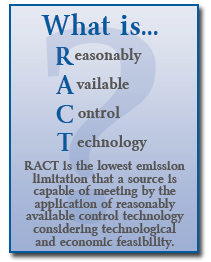Reasonably Available Control Technology (RACT)

Under the Clean Air Act (CAA), a new nonattainment designation by the U.S. Environmental Protection Agency (EPA) for an ozone national ambient air quality standard (NAAQS) requires DEEP to review existing and possibly adopt new RACT for:
(1) all volatile organic compound (VOC) sources covered by a control technique guideline (CTG); and
(2) all major non-CTG sources of oxides of nitrogen (NOx) and VOC.
Currently, Connecticut is in nonattainment of both the 2008 and 2015 ozone NAAQS. In October 2022, the EPA determined that the Greater Connecticut nonattainment area had met the 2008 ozone National Ambient Air Quality Standards (NAAQS). At the same time, the EPA reclassified the New York–New Jersey–Connecticut (NY-NJ-CT) nonattainment area as severe nonattainment for the 2008 ozone NAAQS, effective November 2022. Subsequently, in July 2024, the EPA reclassified both the Greater Connecticut and NY-NJ-CT nonattainment areas as serious nonattainment for the 2015 ozone NAAQS. DEEP has performed a RACT analysis for each original nonattainment designation and each reclassification for the 2008 and 2015 ozone NAAQS.
What do NOx and VOC have to do with Ozone?
Ground-level ozone is not emitted directly into the air by sources, but is created by chemical reactions in the air between NOx, VOC and water droplets. These reactions are accelerated during hot sunny days and these days are typically when ozone levels reach unhealthy levels. To learn more, you can visit our webpage that describes how ozone is formed, and you can always check the current local levels of ozone by visiting the CT Air Quality Index (AQI) website.
Proposed RACT SIP Revision
Reasonably Available Control Measures and Reasonably Available Control Technology Analysis under the 2008 8-Hour Ozone National Ambient Air Quality Standard Reclassification to Severe Non-attainment for the Connecticut Portion of the New York-N. New Jersey- Long Island Non-attainment Area (August 1, 2024)
Final RACT SIP Revisions
Reasonably Available Control Measures and Reasonably Available Control Technology Analysis under the 2008 8-Hour Ozone National Ambient Air Quality Standard - Reclassification to Severe Nonattainment for the CT portion of the NY-NJ-CT Nonattainment Area (November 20, 2025) (NEW)
Attachment A-1 Final RACT SIP
Attachment B Public Notice
Attachment C Public Participation Certification
Attachment D Comment and Response Document
Reasonably Available Control Measures and Reasonably Available Control Technology Analysis under the 2015 8-Hour Ozone National Ambient Air Quality Standard - Reclassification to Moderate Nonattainment for the Greater Connecticut Nonattainment Area (May 22, 2023)
Attachment A-1 Final RACT SIP
Attachment B Public Notice
Attachment C Notice and Public Participation Certification
Attachment D Comment and Response Document
Final RACT SIP Revision for the Serious Designation for the 2008 Ozone NAAQS and the Marginal/Moderate Designations for the 2015 Ozone NAAQS (December 23, 2020)
Attachment A-1 Final RACT SIP Revision
Attachment A-1-1 Attachment NRG - consent order No. 8377
Attachment B Public notice as published on the DEEP website on August 10, 2020
Attachment C Notice and public participation certification
Attachment D Comment and response document
Final RACT SIP Revision for the Marginal Designation for the 2008 Ozone NAAQS (July 17, 2014)
Attachment A Final RACT SIP
Attachment B Public notice
Attachment C Public participation certification
Attachment D Comment and response document
Attachment 1 to Final RACT SIP Revision (July 10, 2014)
RACT and the OTC
The Ozone Transport Commission (OTC) is a multi-state organization created under the CAA to advise the EPA on transport issues and to develop and implement regional solutions to the ground-level ozone problem in the OTR. The OTC developed in 2014 a OTC Statement of RACT Principles with recommendations to assist states in attainment and maintenance of the ozone national air quality standards (NAAQS). The OTC member states strongly believe that the implementation of RACT core principles in this document will strengthen emissions limitations, lower overall emissions, and thereby derive air quality and public health benefits.
Content Last Updated: November 21, 2025

